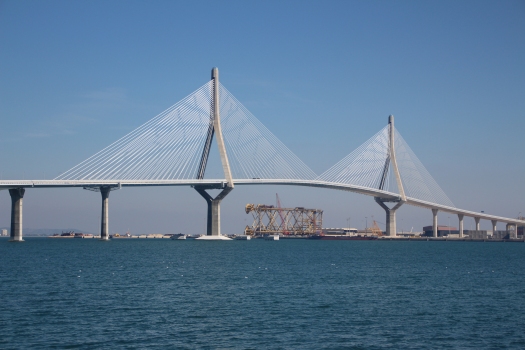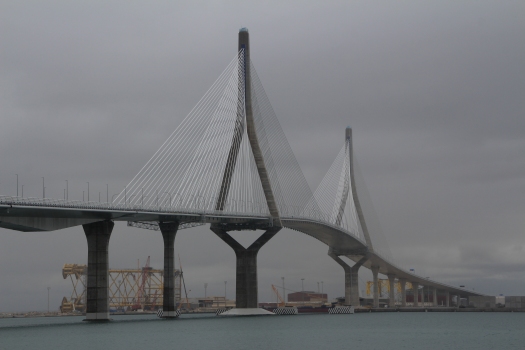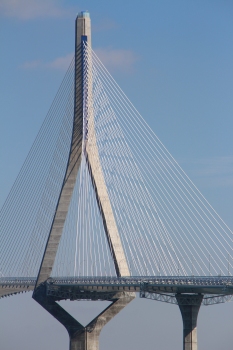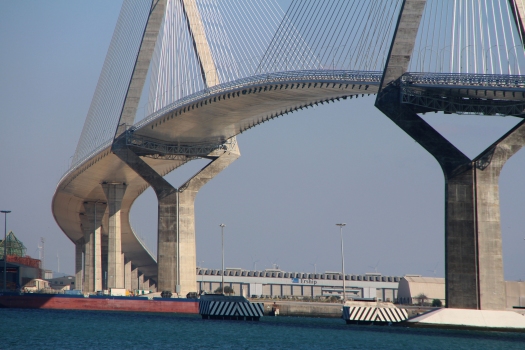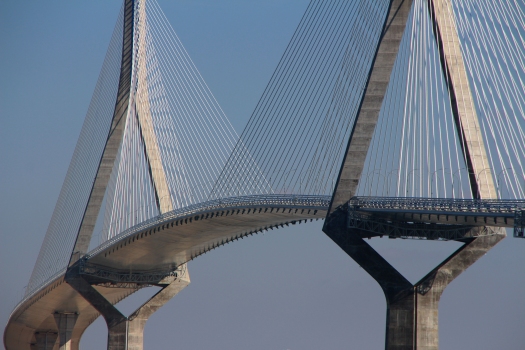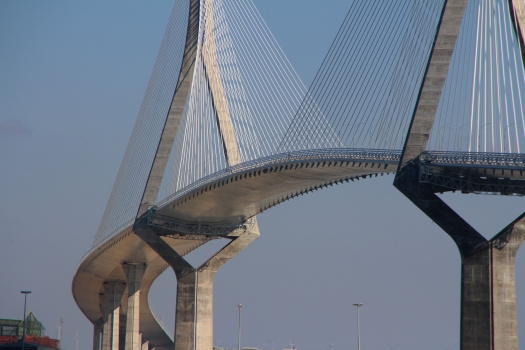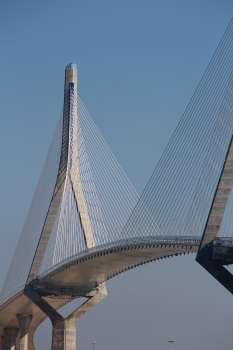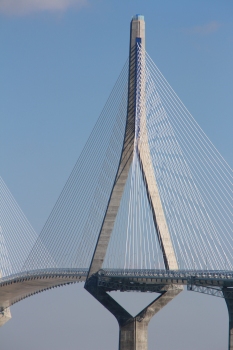General Information
| Name in local language: | Puente de La Pepa; Puente de la Constitución de 1812 |
|---|---|
| Other name(s): | Second Cádiz Bay Bridge |
| Beginning of works: | 2007 |
| Completion: | 24 September 2015 |
| Status: | in use |
Project Type
| Function / usage: |
Road bridge |
|---|---|
| Structure: |
main bridge: Cable-stayed bridge with semi-fan system main bridge: Three-span cable-stayed bridge |
| Material: |
Structurae Plus/Pro - Subscribe Now! |
| Secondary structure(s): |
Structurae Plus/Pro - Subscribe Now! |
| Material: |
Structurae Plus/Pro - Subscribe Now! |
| Secondary structure(s): |
Structurae Plus/Pro - Subscribe Now! |
| Structure: |
removable span: Haunched girder bridge removable span: Box girder bridge removable span: Single-span girder bridge |
Location
| Location: |
Cádiz, Cádiz, Andalusia, Spain |
|---|---|
| Coordinates: | 36° 31' 16.03" N 6° 16' 29.67" W |
| Coordinates: | 36° 31' 31.43" N 6° 14' 26.54" W |
Technical Information
Dimensions
| total length | 3 092 m | |
| deck | width | ø 33.20 m |
| number of lanes | 2 x 3 | |
| removable span | width | 33.20 m |
| span | 150 m | |
| girder depth | 3 - 8 m | |
| eastern approach viaduct | ||
|---|---|---|
| total length | 1 183 m | |
| span lengths | max. 32 m | |
| number of spans | 75 m | |
| main bridge | ||
| main span | 540 m | |
| total length | 1 180 m | |
| span lengths | 120 m - 200 m - 540 m - 200 m - 120 m | |
| pylons | height | 180 m |
| western approach viaduct | ||
| span lengths | 55 - 150 m | |
Cost
| cost of construction | Euro 299 000 000 |
Materials
| piers |
reinforced concrete
|
|---|---|
| pylons |
reinforced concrete
|
| removable span |
steel
(S 355)
|
Case Studies and Applied Products
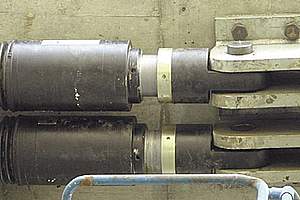
RESTON®STU – Shock Transmission Units
The mageba Shock Transmission Unit (STU) is designed to be connected between bridge structure components to form a rigid link under dynamic loads induced by forces such as vehicle braking and earthquakes. It can be used for strengthening ... [more]
Excerpt from Wikipedia
The Constitution of 1812 Bridge, also known as La Pepa Bridge (El puente de la Constitución de 1812 or Puente de La Pepa in Spanish), is a new bridge across the Bay of Cadiz, linking Cadiz with Puerto Real in mainland Spain.
Cadiz's first bridge, the Carranza bridge, was inaugurated in 1969, and is now crossed by some 40,000 vehicles per day. In 1982 the Spanish government accepted the need for a second bridge.
It has two 180 m pylons, one in the sea and the other in Cabezuelas Harbour, a 540-meter span and 69 meters of vertical clearance. The bridge also includes a 150-meter removal span.
It is the second bridge that crosses over to Cádiz from the mainland, after Carranza bridge, and one of the highest bridges in Europe, with a gauge of 69 meters and 5 kilometers in total length. It is the third access to the city, along with the isthmus San Fernando and the Carranza bridge. Given the large width of the deck, it will be a high capacity bridge: a motorway with two lanes in each direction and two lanes reserved for metropolitan public transport such as the new tram system.
The bill was drafted by the engineer of roads, canals and ports, Javier Manterola. The works were scheduled for completion in 2012, coinciding with the bicentenary of the Spanish Constitution of 1812, which was written in Cádiz. However, due to cuts in public works required by the economic crisis at the time, the work was more than three years late.
In summer 2013 the work had progressed but at a slower pace. Since early 2014 the work has progressed at a good pace, highlighting the installation of its cable-stayed span and hiring more staff working every day (including night shifts). As of the first half of 2015, the bridge structure was completed, providing full completion in September of the same year.
As data highlights:
- The earlier draft described an arch bridge whose total length was 2.355 km.
- The total length of the current project, viaducts and links is 5 kilometers: 3096 meters on the bridge of which 1655 meters will be over the sea, with a main span of 540 meters record of Spain, with one hundred meters more than the bridge engineer Carlos Fernández Casado, famous engineer of roads, canals and ports, the reservoir Barrios de Luna. Besides the vain is the third largest in Europe suspended class, after Rio-Antirio Bridge and Normandy Bridge.
- The maximum height above the sea level is 69 meters, with two pylons of 187 meters, making it one of the tallest bridges in Europe.
- They are 30 meters higher than the pylons between both sides of the bay.
The bridge connects the neighborhood of San Pedro River to Puerto Real with the neighborhood of La Paz of Cadiz.
The construction project
View from the Port of Cadiz La Pepa Bridge is an extension of CA-35 road to cross the Cadiz Bay. Carranza Bridge is an extension of CA-36 road. They save 20 km (12.75 mi).
The proposed construction of a new access to the city of Cadiz by a bridge over the Bay has its starting point in the Order of Highways Studies during April 2003, which in turn took account of various studies from 1989. This project's aim was to respond to traffic congestion problems that have been suffering from the access to Cadiz from Puerto Real (Bridge José León de Carranza and CA-33).
In the draft were studies for three riders that link the N-443 in the San Pedro Bay crossing access into Cádiz:
- A. Northern Zone Cabezuela straight through Bay area reaching the shipyard in Cadiz, past the northern edge of spring Cabezuela.
- B. The limit shipyards factory in Matagorda, and after passing through the southern end of spring Cabezuela, describes an arc in the bay to reach the area also shipyards in Cádiz, thus saving the channel navigation, in order to reduce the junction depth.
- C. Continued on the trace of the N-443, and when one reaches the edge of the bay, on the southern edge of Astilleros de Matagorda, crosses S for describing a road connecting with the city in the Props area, connecting with the new diagonal Avenue and Bay.
In all three cases a cross section separated by two lanes, shoulders and median lanes are envisioned.
Regarding the crossing structure bay, the three paths are designed in submerged tunnel. Moreover, in the "A" alternative solution fixed bridge large gauge was studied because it was the only one whose configuration permitted naturally, across a single alignment channel surfing and having a path straight admitting great light openings for the passage of ships. Similarly, three alternatives were studied bridge: archery, cable-stayed and suspension.
The "A" alternative structure bridge for crossing the Bay was selected as the best solution for urban traffic on both banks of the bay, the lowest investment also considered that nicely integrates both urban planning and landscape.
Of the different types of bridge studied, the braced was selected as the lowest cost and the simplest structural concept.
Execution of the work
Its construction has been contracted to the joint venture (UTE) formed by Dragados and DRACE (Special and Dragados Construcciones). The project has a budget of 273 million euros, and their duration is estimated at 42 months.
Up to 500 workers were directly employed in times of maximum intensity.
Description
It is a highway whose speed adopted in the project, as permitted approval of the draft, has been set at 80 km/h, justified based on the urban nature of the performance.
The bridge has a total length of 4580 meters, with the following lights in the sea:
- Access to Cadiz: 25 meters × 7 meters; 75 meters
- Stretch detachable: 150 meters
- Access Puerto Real: 850 meters
The suspension bridge is the highest stretch with maximum longitudinal slope of 5%. On land the bridge is built on the industrial area of La Cabezuela, releasing the existing road condition.
It has three lanes in each direction for vehicular traffic, with central median 0.8 meters with a rigid barrier, and side sidewalks with net width of 1.30 meters. The total width of the bridge is 30.5 meters except where the bracing section expands 32.5 meters to accommodate suspension struts.
Dredging
The layer of Quaternary materials is dredged so that sidewalks foundation of pile caps settle to the firm layer of Pliocene, and poured into the high seas.
Bridge pylons
Of the 39 support, 37 batteries + 2 stirrups, 12 are in the sea, all by in site piles 2 meters in diameter, with embedding in the Pliocene.
Stirrup Cádiz
The bridge begins in a vial, with the preferred direction to and from the new bridge, a roundabout in the capital, maintaining connections and access to it on the surface.
Cadiz access
Its length is 581.2 meters with a mixed structure and topped with concrete ribbed floor slabs. The vain guy is 75 meters above the batteries, which are supported by pylons. The pylons are 30 meters deep with 4–6 pylons.
Battery sections are formed by a double gap with widths ranging from 4.00 to 2.9 trapezius meters depending on the height and between 32.079 meters and 7,804 meters. At the top of this stack, it widens a reach of 10.5 meters which is to gather support with neoprene Teflon, 2700 tons payload, except for the battery 1 will be 2500 tons.
Text imported from Wikipedia article "La Constitución de 1812 Bridge" and modified on May 27, 2020 according to the CC-BY-SA 4.0 International license.
Participants
-
Carlos Fernández Casado S.L.
- Javier Manterola (designer)
Relevant Web Sites
Relevant Publications
- (2016): Acabados y unidades complementarias en el Puente de la Constitución de 1812 sobre la Bahía de Cádiz. In: Hormigón y acero, v. 67, n. 278-279 (January 2016), pp. 267-272.
- (2016): Aspectos generales y casos concretos de los trabajos de supervisión estructural del proceso constructivo y medios auxiliares del Puente de la Constitución de 1812 sobre la Bahía de Cádiz. In: Hormigón y acero, v. 67, n. 278-279 (January 2016), pp. 277-285.
- (2016): Auscultación dinámica de tirantes del Puente de la Constitución de 1812 sobre la Bahía de Cádiz. In: Hormigón y acero, v. 67, n. 278-279 (January 2016), pp. 195-197.
- (2016): Bases y aspectos relevantes del cálculo del tramo atirantado del Puente de la Constitución de 1812 sobre la Bahía de Cádiz. In: Hormigón y acero, v. 67, n. 278-279 (January 2016), pp. 87-98.
- (2016): Cálculo y control detallado del proceso de construcción del tramo atirantado del Puente de la Constitución de 1812 sobre la Bahía de Cádiz. In: Hormigón y acero, v. 67, n. 278-279 (January 2016), pp. 111-122.
- About this
data sheet - Structure-ID
20024691 - Published on:
03/11/2006 - Last updated on:
25/07/2020

